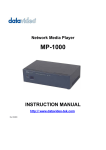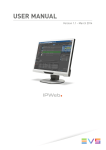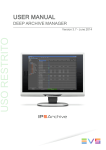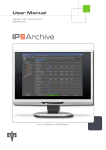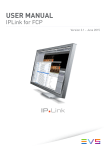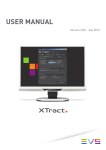Download User Manual - MAD V1.5 MAD Filing V3.3
Transcript
USER MANUAL MAD Filing Version 1.5 - February 2015 USER MANUAL MAD 1.5 MAD Filing Copyright EVS Broadcast Equipment S.A.– Copyright © 2003-2015. All rights reserved. Disclaimer The information in this manual is furnished for informational use only and subject to change without notice. While every effort has been made to ensure that the information contained in this user manual is accurate, up-to-date and reliable, EVS Broadcast Equipment cannot be held responsible for inaccuracies or errors that may appear in this publication. Improvement Requests Your comments will help us improve the quality of the user documentation. Do not hesitate to send improvement requests, or report any error or inaccuracy on this user manual by e-mail to [email protected]. Regional Contacts The address and phone number of the EVS headquarters are usually mentioned in the Help > About menu in the user interface. You will find the full list of addresses and phone numbers of local offices either at the end of this user manual (for manuals on hardware products) or at the following page on the EVS website: http://www.evs.com/contacts. User Manuals on EVS Website The latest version of the user manual, if any, and other user manuals on EVS products can be found on the EVS download center, on the following webpage: http://www.evs.com/downloadcenter. I USER MANUAL MAD 1.5 MAD Filing Table of Contents TABLE OF CONTENTS III WHAT'S NEW? V 1. ABOUT THE APPLICATION 1 2. INSTALLING THE APPLICATION 3 3. STARTING THE APPLICATION 3 3.1. After Installation 3 3.2. After Configuration 4 3.3. Version and License Check 6 3.4. Main Window Overview 8 4. MANAGING INGEST REQUESTS 4.1. Ingest View 12 4.1.2. Requested Tab 13 4.1.3. Tape Based Tab 17 4.1.4. Request Executed Tab 18 4.1.5. Filed Tab 21 22 4.2.1. Dispatching Ingest Requests to IPDirector 22 4.2.2. Undoing Ingest Requests Dispatched to IPDirector 24 4.2.3. Retrying Ingest Requests Dispatched to IPDirector 25 4.2.4. Monitoring File-Based Ingest Requests 26 4.2.5. Retrying File-Based Ingest Requests 26 4.2.6. Undoing File-Based Ingest Requests 26 ACCEPTING AND REJECTING INGESTED SEGMENTS 27 5.1. Introduction 27 5.2. Acceptance View 27 5.3. Displaying the Differences in Timecodes and Duration 28 5.4. Accepting Segments with a Timecode Difference 29 5.5. Rejecting Segments with a Timecode Difference 30 6. ACCEPTING AND REJECTING PURGE REQUESTS 6.1. Introduction Table of Contents 12 4.1.1. Overview 4.2. Dispatching, Monitoring, Undoing and Retrying Ingest Requests 5. 12 31 31 III EVS Broadcast Equipment S.A. 6.2. Purge View 31 6.3. Accepting Purge Requests 32 6.4. Rejecting Purge Requests 33 7. MANAGING GRIDS 34 7.1. Introduction 34 7.2. Manipulating Columns 34 7.2.1. Adjusting the Width of Columns 34 7.2.2. Reordering Columns 34 7.2.3. Adding and Removing Columns 36 7.2.4. Hiding and Unhiding Columns 37 7.3. Copying Data 37 7.4. Sorting Data 38 7.5. Filtering Data 39 7.5.1. Filtering by Values From a Column 39 7.5.2. Filtering by Criteria 40 7.6. Grouping Data 43 7.7. Performing Basic Calculations on Data 45 7.7.1. Footers and Basic Calculations 45 7.7.2. Performing Basic Calculations on Non-Grouped Data 46 7.7.3. Performing Basic Calculations on Grouped Data 48 7.7.4. Removing Footers 49 8. CONFIGURING THE APPLICATION 50 8.1. Settings Window 50 8.2. User Settings 52 8.2.1. Overview User Settings Subcategories 52 8.2.2. General Tab 52 8.2.3. Tape Based Filing Tab 54 8.3. System Settings IV Issue 1.5.D - February 2015 56 8.3.1. Overview System Settings Subcategories 56 8.3.2. Oracle Connection Tab 57 8.3.3. E-Mail Options Tab 60 Table of Contents USER MANUAL MAD 1.5 MAD Filing What's New? In the User Manual the icon has been added on the left margin to highlight information on new and updated features. The changes linked to new features in version 3.3 are listed below. MAD Filing now writes files to the AppData folder instead of it's own executable folder. MAD Filing has been adapted to support the move of assets in Media Manager. MAD Filing now uses the correct hierarchical level names in its interface. A Filed tab has been added containing all files that have been ingested. See section "Filed Tab" on page 21. What's New? V USER MANUAL MAD 1.5 MAD Filing 1. About the Application General Description MAD Filing forms part of the ingest module of the central archiving system MediArchive Director (MAD). It displays all the requests to ingest specific video and/or audio segments into the digital archive, as well as the requests to purge particular segments. The ingest and purge requests were performed in MAD Media Manager or in an external application through the MAD API (Application Programming Interface). It enables users to manually dispatch tape-based ingest requests to IPDirector and to monitor the status and progress of file-based ingest requests that are automatically processed. Once the video and/or audio material has been ingested, a check is performed on it. The start and end timecode (TC In and TC Out) and duration of the ingested material is compared with the timecodes and duration entered in the MAD database. In case of a difference, MAD Filing will display the video and/or audio files in question and let the users decide to accept or reject the files. Accepted files will become part of the digital archive and the different timecodes are updated in the MAD database. Rejected files will be purged automatically from the archive. MAD Filing also allows users to manually initiate the purge process for video and/or audio material that has been requested to be purged and to monitor the status and progress of the purge process. Workflow The diagram below illustrates the position and function of MAD Filing in the ingest and purge workflows. 1. About the Application 1 EVS Broadcast Equipment S.A. Issue 1.5.D - February 2015 Multiple Timecode Support The application supports the following SMPTE timecodes: 2 • PAL • NTSC non-drop frame • NTSC drop frame 1. About the Application USER MANUAL MAD 1.5 MAD Filing 2. Installing the Application See the MAD Installation manual for more information on how to install the application. 3. Starting the Application 3.1. After Installation To start the application after installation, proceed as follows: 1. Double-click the MAD Filing icon on the server desktop to start the application. You can also launch the application by double-clicking the executable file (.exe) in the installation folder. The application splash screen appears while the application logs into the MAD database. Then, the Settings window appears allowing you to configure the application. See section "Settings Window" on page 50. 2. Installing the Application 3 EVS Broadcast Equipment S.A. 3.2. Issue 1.5.D - February 2015 After Configuration To start the application after it has been configured, proceed as follows: 1. Double-click the MAD Filing icon on the server desktop to start the application. You can also launch the application by double-clicking the executable file (.exe) in the installation folder. The application splash screen appears while the application logs into the MAD database. Next, the Login dialog box of the application appears. To be able to log into the application, you need to belong to a user group that has a role which allows to use the application. 2. Enter your username and password and click Login. The main window of the application opens. You get an error notification if: • 4 you have entered a wrong username or password. 3. Starting the Application USER MANUAL MAD 1.5 MAD Filing • you have omitted your username. • you have insufficient user rights. • your login has expired. Warning If you have lost your password, a new password will have to be set in MAD Config. Contact your system administrator. 3. Starting the Application 5 EVS Broadcast Equipment S.A. 3.3. Issue 1.5.D - February 2015 Version and License Check Introduction The version of the application and the validity of the application license will be checked when the application logs into the MAD database at startup. The status of the version or the license that is returned is displayed on the application splash screen. Version and License Statuses The following version and license statuses can be returned: Status Description Color Action Required Current The actual version of the application. no color No action required. The application starts automatically. Outdated A newer version of the application exists, but this version can still be used. red By default, the application starts automatically after 10 seconds. The application version that should be installed is displayed. Obsolete A newer version of the application exists and must be used. This version may not be used anymore. Click OK to start the application at once. red Click OK to continue. The application shuts down. The application version that should be installed is displayed. Undefined The version of the application is not defined in the MADdatabase. black Click OK to continue. The application shuts down. Beta A test version. blue Click OK to start the application. By default, the application starts automatically after 10 seconds. 6 3. Starting the Application USER MANUAL MAD 1.5 MAD Filing Status Description Color License About to Expire The license period is about to expire. It is shown in how many days the license will expire. orange Click OK to start the application at once. By default, the application starts automatically after 10 seconds. Contact your system administrator or check the License Controller manual. License Expired The license period has expired. The date when the license expired is displayed. Action Required red Click OK to continue. The application shuts down. Contact your system administrator or check the License Controller manual. No Valid License There was no valid license found in the database. red The application shuts down. Contact your system administrator or check the License Controller manual. Maximum Licenses Reached The maximum number of instances <NUMBER OF LICENSES> for the license has been reached. Click OK to continue. red Click OK to continue. The application shuts down. Contact your system administrator or check the License Controller manual. 3. Starting the Application 7 EVS Broadcast Equipment S.A. 3.4. Issue 1.5.D - February 2015 Main Window Overview General Description The main window enables you to handle and/or monitor the requests to ingest particular video and/or audio segments into the digital archive, as well as the requests to purge specific segments. It also allows you to accept or reject segments that have been ingested, but for which a difference in timecode and/or duration has been detected between the ingested file and the MAD database. Finally, it allows you to accept or refuse the deletion of segments that did not pass the quality check because of poor quality or that have been requested to be purged. Illustration The main window contains the areas highlighted on the screenshot below: 8 3. Starting the Application USER MANUAL MAD 1.5 MAD Filing Area Description The table below describes the various parts of the main window: Part Name Description 1. Menu bar The menu bar contains three settings: File, Settings and Help. 2. Active view This pane displays the active view. Depending on the ingest workflows in your MAD setup, more or less views will be available. See section "General Tab" on page 52. 3. Navigation bar The Navigation bar contains buttons that allow you to quickly navigate between the various views in MAD Filing. Depending on the number of active views, more or less navigation buttons will be available. See section "General Tab" on page 52. There are three groups of navigation buttons: Ingest, Acceptance and Purge. Each group represents a phase in the ingest process. To hide the navigation buttons of a group, click . To show them again, click . Next to the header of the group the total number of active records is displayed between brackets. Menu Bar The menu bar contains three menus: File, Settings and Help. File Menu The File menu contains two commands: Logout and Exit. Click the File menu or use the keyboard shortcut keys ALT + F or F10 + F to open it. Click Exit or use the keyboard shortcut key X to exit the application. Click Logout or use the keyboard shortcut key O to log out of the application. Settings Menu The Settings menu does not contain any commands. It immediately gives access to the application settings. Click the Settings menu or use the keyboard shortcut keys ALT + S or F10 + S to access the settings. Help Menu The Help menu contains the following commands: Help, Context-Sensitive Help and About. With the Help command you can open the application help file. 3. Starting the Application 9 EVS Broadcast Equipment S.A. Issue 1.5.D - February 2015 With the Context-Sensitive Help command you can turn on or off the context-sensitive help mode. In context-sensitive help mode, when you click a user interface item, help for that item is displayed. You can also turn on or off context-sensitive help mode by pressing F1. With the About command the application about box can be opened. The about box displays the application software version, the date until which the application license is valid, the name and version of the database the application is logged on to and the login name used. Click About or use the keyboard shortcut key A to open the application about box. Views The main window of MAD Filing contains the following views: View Description Ingest This view displays the requests originating from Media Manager or from an external application through the MAD API to ingest specific video and/or audio segments into the digital archive. In this view the users can manually dispatch the tape-based ingest requests to IPDirector. They can also monitor the progress and status of the automatic file-based ingest requests. See section "Ingest View" on page 12. In case of a problem or error, ingest requests can be undone and retried. See section "Dispatching, Monitoring, Undoing and Retrying Ingest Requests" on page 22. Acceptance This view displays the ingested segments for which a difference in timecode and/or duration was detected. In this view the users have to manually accept or reject the ingested segments. Accepted segments will remain filed, rejected segments will be offered to be purged. See section "Acceptance View" on page 27. 10 3. Starting the Application USER MANUAL MAD 1.5 MAD Filing View Description Purge This view displays the ingested segments that have been requested in Media Manager, MAD Filing or in an external application to be purged from the archive. In this view the users can manually accept and start the purge process, or reject a segment from being purged. See section "Purge View" on page 31. 3. Starting the Application 11 EVS Broadcast Equipment S.A. Issue 1.5.D - February 2015 4. Managing Ingest Requests 4.1. Ingest View 4.1.1. Overview General Description This view displays the requests to ingest particular video and/or audio segments into the digital archive. Illustration The Ingest view contains the areas highlighted on the screenshot below: 12 4. Managing Ingest Requests USER MANUAL MAD 1.5 MAD Filing Area Description The table below describes the various parts of the Ingest view: Part 1. Name Description Requested tab This tab displays the video and/or audio segments that have been requested to be ingested into the digital archive. The ingest requests have not yet been dispatched to IPDirector or have not yet been picked up by the MAD system to be further processed. Between brackets the number of records is displayed. See section "Requested Tab" on page 13. 2. Request Executed tab This tab displays the segments whose ingest request has been dispatched to IPDirector or has been picked up by the MAD system to be further processed. See section "Request Executed Tab" on page 18. 3. Filed tab This tab displays the segments that have been ingested into the MAD archive. See section "Filed Tab" on page 21. 4. Tape Based tab This tab displays the segments belonging to a particular video tape that need to be digitized and ingested into the archive using IPDirector. The user has selected the tape from the Requested tab. It allows the user to manually dispatch the ingest request to IPDirector. See section "Tape Based Tab" on page 17. Depending on your MAD setup and on the configuration of MAD Filing, this tab may or may not be available. 4.1.2. Requested Tab Introduction The Requested tab groups the requests originating from Media Manager or an external application through the MAD API to ingest video and/or audio segments into the digital archive. The segments can be contained on a video tape or audio CD or can be video or audio files. Detailed information about the requests and segments is displayed in a grid which can be customized to your needs. The information can be filtered, sorted and grouped. Columns can be resized, rearranged, removed, hidden and added or made visible again. See section "Managing Grids" on page 34. 4. Managing Ingest Requests 13 EVS Broadcast Equipment S.A. Issue 1.5.D - February 2015 The number of requests is displayed between brackets next to the tab title. Ingest Request Metadata The information about an ingest request can be divided into three categories: • information about the request itself • information about the segment to be ingested • information about the asset item. Information About the Ingest Request The table below describes the information that is displayed about each ingest request. 14 Column Description Requested Indicates the date and time the ingest of the segment was requested in Media Manager or in the external application through the MAD API. Status Indicates the status of the ingest request. In the Requested tab all segments have the status Filing Requested (yellow). It means that the ingest has been requested, but has not yet been dispatched by MAD Filing to IPDirector or has not yet been picked up by the MAD system to be further processed. 4. Managing Ingest Requests USER MANUAL MAD 1.5 MAD Filing Information About the Segment The table below describes the information that is displayed about each segment. Column Description Audio Indicates if the segment is audio material or not. Subcategory Indicates the subcategory the segment belongs to. Asset External ID Indicates the external ID assigned to the asset the segment belongs to. Asset External Title Indicates the external title assigned to the asset the segment belongs to. Asset No. Indicates the asset sequence number. Asset Title Indicates the title of the asset the segment belongs to. External ID Indicates the external ID assigned to the segment. External Title Indicates the external title assigned to the segment. Asset ID Indicates the ID that was automatically assigned to the asset by the MAD system. Media ID Indicates the ID assigned to the segment by the MAD system. This ID will be used to keep track of the segment throughout the entire archive workflow. Prev. Ingested Indicates if the segment has already been ingested into the archive or not. Grouping Category Title Indicates the title of the grouping category the segment belongs to. Requested File Format Indicates the file format the segment should be converted to when ingesting. Source Type Indicates the source type of the segment, e.g. Audio File, Audio CD, etc. Subcategory Indicates the subcategory the segment belongs to. Subtitle Indicates the subtitle of the segment. TC In Indicates the start timecode of the segment as entered in the MAD database. TC Out Indicates the end timecode of the segment as entered in the MAD database. Title Indicates the title of the segment. It consists of the following information: program title, episode title and segment name. Video Standard Indicates the video standard of the segment, e.g. SD, HD. In case of an audio file, the standard is set to ‘[unknown]’. Video Format Indicates the video or audio format, e.g. SD - 4:3, Audio 96 KHz / 24 bit. 4. Managing Ingest Requests 15 EVS Broadcast Equipment S.A. Issue 1.5.D - February 2015 Information About the Asset Item The table below describes the information that is displayed about the asset item ( = storage medium) that contains the segment. 16 Column Description Asset Item ID Indicates the ID assigned to the asset item by the MAD system. Asset Item Name Indicates the name of the asset item as entered in the MAD database. Asset Item External ID Indicates the external ID assigned to the asset item. Asset Item External Title Indicates the external title assigned to the asset item. Carrier Type Indicates the type of asset item, e.g. video - tape, audio - file. Carrier Indicates the format of the asset item, e.g. Betacam SP, WAV BWF (96). 4. Managing Ingest Requests USER MANUAL MAD 1.5 MAD Filing 4.1.3. Tape Based Tab Introduction The Tape Based tab displays the segments of one or more video tapes the user wants to ingest into the archive using IPDirector. It consists of two main areas: the Selected Tape grid and the Selected Target grid. Selected Tape Grid The Selected Tape grid displays the segments of the video tape the user has selected in the Ingest Requests grid. Above the grid the following information about the selected video tape is displayed: the external (= customer) or MAD tape ID (this can be configured in the settings), the video standard (e.g. SD, HD), the video format (e.g. SD - 4:3), the carrier type (e.g. Betacam SP) and the requested archive file format (e.g. IMX 40 MXF OP1A (SMPTE). Selected Target Grid The Selected Target grid displays the targets the user can select to ingest the segments of the video tape. The targets have been configured in the settings. 4. Managing Ingest Requests 17 EVS Broadcast Equipment S.A. Issue 1.5.D - February 2015 Each target consists of the following elements: 4.1.4. Element Description Source The name of the video tape recorder used during the digitization of the segments to play out the video tape. This name can refer for example to the video format of the video tape and the requested file format. This name can be configured in the settings. See section "Tape Based Filing Tab" on page 54. Asset Item ID The ID assigned to the video tape by the MAD system. This ID appears once the user has clicked the Request button. Asset Item Name The name of the tape. This name appears once the user has clicked the Request button. Batchfile The name of the IPDirector batch file (.csv). This name appears once the user has clicked the Request button. The form of the .csv file can be defined in the settings. See section "Tape Based Filing Tab" on page 54. Batch Folder The folder on the IPDirector server were MAD Filing will drop the batch file. The path of this folder can be configured in the settings. See section "Tape Based Filing Tab" on page 54. Target The name of the target as configured in IPDirector. This target can be configured in the settings. See section "Tape Based Filing Tab" on page 54 Request Executed Tab Introduction The Request Executed tab displays the segments of which the ingest request was dispatched to IPDirector by the user or was picked up by the MAD system to be further processed. It also briefly displays the segments that have been successfully ingested. The segments are grouped in tabs according to the method used to ingest the segments. Tape Based Tab The Tape Based tab displays the segments of which the ingest request was dispatched to IPDirector by the user. The number of segments is displayed between brackets next to the tab title. It also briefly displays the segments that were successfully ingested. The ingest request can be undone, or in case of an error or a mistake, retried. See section "Retrying Ingest Requests Dispatched to IPDirector" on page 25 and "Undoing Ingest Requests Dispatched to IPDirector" on page 24. 18 4. Managing Ingest Requests USER MANUAL MAD 1.5 MAD Filing File Based Tab The File Based tab displays the segments whose ingest was automatically requested and of which the request has been picked up by the MAD system to be further processed. The number of segments is displayed between brackets next to the tab title. It allows you to monitor the status and progress of the ingest process. In case of an error, the ingest process can be retried or undone. It also briefly displays the segments that were successfully ingested. Ingest Request Metadata In the Tape BasedTab The information that is displayed about the ingest requests is almost identical to the information displayed in the Requested tab. The table below describes the additional information. Column Description Ingested Indicates if the segment has been successfully ingested. Ingested Date Indicates the date and time the segment was ingested. Req. Indicates if the ingest request was manually or automatically dispatched or not. Status The ingest requests can have one of the following statuses: • Filing Request Executed (orange): The ingest request has been dispatched by MAD Filing. • Filed (green): The ingest has been completed. • Failed (red): The ingest process failed. 4. Managing Ingest Requests 19 EVS Broadcast Equipment S.A. Issue 1.5.D - February 2015 In the Automatic File Based Ingest Tab The table below describes the additional information that is displayed in the Automatic File Based Ingest tab. Column Description Ext. The file extension of the video or audio file that has to be ingested. Conversion Status Conversion status of the file: • Requested: The video conversion process has been requested. • Assigned: A transcoding tool (e.g. XTAccess, Rhozet, etc.) has been searched for and has been assigned. • Req. Exec.: The conversion request has been passed on to the conversion tool. • Processing:The conversion process is busy. • Done: The conversion process has been completed successfully. • Failed: The conversion process has failed. Current TC Current timecode of the segment that is being ingested. Dest. Folder Folder on the online storage where the ingested high-resolution files will be or are stored. File TC In Start timecode of the video file. File TC Out End timecode of the video file. Ingest TC In Start timecode of the ingested file. Ingest TC Out End timecode of the ingested file. Progress Progress of the conversion process expressed in percentage. Source File The video or audio file that has to be or has been ingested. Source Folder Watch folder where the file to be ingested is dropped. Status The ingest requests can have one of the following statuses: • Filing Request Executed (orange): The ingest request has been picked up by the MAD system. The ingest process is busy. • Filed (green): The ingest has been completed successfully. • Failed (red): The ingest process has failed. Target Video ID ID of the ingested file. Target Video Name Name of the ingested file. 20 4. Managing Ingest Requests USER MANUAL MAD 1.5 MAD Filing 4.1.5. Filed Tab The Filed tab displays the segments that have been ingested into the MAD archive. Depending on the configuration of MAD Filing, the segments will be removed after a predefined period of time. See section "General Tab" on page 52. 4. Managing Ingest Requests 21 EVS Broadcast Equipment S.A. Issue 1.5.D - February 2015 4.2. Dispatching, Monitoring, Undoing and Retrying Ingest Requests 4.2.1. Dispatching Ingest Requests to IPDirector To dispatch an ingest request to IPDirector, proceed as follows: 1. Open the Ingest view. 2. In the Ingest Requests grid of the Requested tab, double-click one of the segments that belongs to the tape whose content you want to ingest through IPDirector. If by accident you click a segment of which the source type is not 'Tape', a warning message will appear. Click OK to continue and double-click a segment with the appropriate source type. All the segment of that tape that have been requested to be ingested appear in the Selected Tape grid of the Tape Based tab. Above the grid the following information is displayed: the MAD or external asset item ID, the video standard, the video format, the carrier type and the requested archive file format. 3. In the Selected Target grid, select the appropriate target from the list, and then click the Request button. Note that if an ingest request has already been assigned to the target you selected, the Request button will be unavailable. A message box appears asking you to confirm the action. 4. Click Yes to proceed. 22 4. Managing Ingest Requests USER MANUAL MAD 1.5 MAD Filing The segments disappear from the Requested tab and appear in the Tape Based tab of the Request Executed tab. The status of the segments has changed into ‘Filing Req. Exec.’ MAD Filing will drop a batch file (.csv) containing information about the segments and the selected target in a folder (C:\IPD_Batchlist\) on the IPDirector server. The IPDirector operator will have to import this file into the IPDirector VTR Control panel. The name of the batch file can be configured in the MAD Filing settings. It can contain one or more of the following tags: ◦ Source ID ◦ Asset ID ◦ Asset Title ◦ Asset External ID ◦ Asset External Title ◦ Asset Item ID ◦ Asset Item Name ◦ Asset Item External ID ◦ Asset Item External Title The batch file contains the following information: ◦ Clipname ◦ Asset Item ID ◦ VarID ◦ TC In ◦ TC Out ◦ Keywords (which can be configured in the MAD Filing settings) The IPDirector operator has to start the ingest process. Once the segments have been ingested and the video files are available on the IPDirector nearline storage and no timecode difference was detected, MAD Filing will automatically remove the .csv file from the folder C:\IPD_Batchlist\ on the IPDirector server. The status of the segments will change to ‘Filed’. The Nearline check box will be selected. The target will become available again. 4. Managing Ingest Requests 23 EVS Broadcast Equipment S.A. 4.2.2. Issue 1.5.D - February 2015 Undoing Ingest Requests Dispatched to IPDirector Introduction Ingest requests that have been dispatched to IPDirector can be undone in two areas of the Ingest view: • in the Selected Target grid of the Requested tab. This is possible as long as the ingest request has not been picked up by the conversion tool XTAccess. Once XTAccess picks up and starts processing the ingest request, the selected target is no longer assigned to a tape and the Undo Request button is no longer available. The ingest request can then only be undone in the Tape Based tab of the Request Executed tab. • in the Tape Based tab of the Request Executed tab. Undoing an Ingest Request in the Requested Tab To undo an ingest request that has been dispatched to IPDirector, proceed as follows: 1. In the Selected Target grid, select the appropriate target. 2. Click the Undo Request button. A message box appears asking you to confirm the action. 3. Click OK to continue or Cancel to abort the action. MAD Filing will remove the batch file from the folder (C:\IPD_Batchlist\) on the IPDirector server. The segments will disappear from the Request Executed tab and appear again in the Requested tab with the status 'Filing Requested'. Note that this will not remove the file from the IPDirector VTR Control Panel and will not abort the ingest process if already running. This has to be checked and aborted in IPDirector. Note As long as none of the segments have been successfully ingested, you can undo the ingest request. As soon as one segment has been successfully ingested, the Undo Request button will be unavailable. 24 4. Managing Ingest Requests USER MANUAL MAD 1.5 MAD Filing Undoing an Ingest Request in the Request Executed Tab To undo an ingest request in theTape Based tab of the Request Executed tab, proceed as follows: 1. In the Tape Based tab, select the desired ingest request. 2. Click the Undo button . A warning message appears asking you to make sure that all residual files, i.e. the IPDirector batch list file, the XTAccess metadata file (if any) and part of the ingested video file (if any) have been removed first. 3. Click Yes to continue. The segments will disappear from the Request Executed tab and appear again in the Requested tab with the status 'Filing Requested'. 4.2.3. Retrying Ingest Requests Dispatched to IPDirector To retry an ingest request that was dispatched to IPDirector and that failed, proceed as follows: 1. Open the Ingest view. 2. Open the Request Executed tab. 3. Open the Tape Based tab. 4. Select the ingest request with the status 'Failed'. 5. Click the Retry button . This button only appears if the ingest process failed. The ingest request will disappear from the Request Executed tab and appear again in the Requested tab with the status 'Filing Requested'. As soon as the conversion process has been requested again, the segment will appear again in the Tape Based tab of the Request Executed tab with the status 'Request Executed' and the ingest process will start again. 4. Managing Ingest Requests 25 EVS Broadcast Equipment S.A. 4.2.4. Issue 1.5.D - February 2015 Monitoring File-Based Ingest Requests In the file-based ingest workflow, a person drops one or more video files that have to be ingested in the archive in a predefined watch folder. In Media Manager this user creates a segment for each of these video files. Then, each video file is loaded in the Media Browser of Media Manager. There, the user marks a start (=TC In) and end point (=TC Out) and links the video file to the corresponding segment. Then, the user requests the ingest of each segment. See the Media Manager user manual for more information. As soon as the ingest is requested in Media Manager, the segments appear in the Requested tab of MAD Filing. As soon as the conversion of the video files is requested, the segments appear in the Request Executed tab. There, the user can monitor the status and progress of the ingest process. In case of an error, the ingest workflow can be retried or undone. 4.2.5. Retrying File-Based Ingest Requests To retry a file-based ingest request that failed, proceed as follows: 1. Open the Ingest view. 2. Open the Request Executed tab. 3. Open the File Based tab. 4. Select the ingest request with the status 'Failed'. 5. Click the Retry button . This button only appears if the ingest process failed. The ingest request will disappear from the Request Executed tab and appear again in the Requested tab with the status 'Filing Requested'. As soon as the conversion process has been requested again, the segment will appear again in the Automatic File Ingest tab of the Request Executed tab with the status 'Request Executed' and the ingest process will start again. 4.2.6. Undoing File-Based Ingest Requests To undo a file-based ingest request, proceed as follows: 1. Open the Ingest view. 2. Open the Request Executed tab. 3. Open the File Based tab. 4. Select the ingest request with the status 'Failed'. 5. Click the Undo button . The ingest request will disappear from MAD Filing. In Media Manager the Filing action will have to be manually requested again. See the Media Manager user manual for more information. 26 4. Managing Ingest Requests USER MANUAL MAD 1.5 MAD Filing 5. Accepting and Rejecting Ingested Segments 5.1. Introduction Once segments have been ingested into the archive, a check is performed in the MAD database to see if the timecodes (TC In and TC Out), duration and video format entered for each segment in Media Manager or in an external application through the MAD API correspond with the timecodes, duration and video format of the high-resolution files in the archive. When a difference is detected for a segment, the segment will appear in the Acceptance view. In this view you will have to manually accept or reject the segment. 5.2. Acceptance View General Description The Acceptance view displays the segments (video or audio) that have been ingested in the archive and for which a difference in timecodes, duration and/or video format was detected. The segments are grouped into tabs according to the type of ingested content: audio or video, and according to the ingest method: file- or tape-based and manual or automatic. Audio segments are also grouped according to carrier: file or CD. To open the Acceptance view, click the corresponding button in the navigation bar. 5. Accepting and Rejecting Ingested Segments 27 EVS Broadcast Equipment S.A. Issue 1.5.D - February 2015 Tabs Depending on your MAD setup and the configuration of MAD Filing, one or more of the following tabs will be visible: • Tape Based: This tab displays segments of video tapes that have been ingested in the archive using IPDirector. • File Based: This tab displays video files that have been automatically ingested in the archive. • Audio File: This tab displays audio files that have been ingested in the archive. • Audio CD: This tab displays segments representing audio tracks that have been ripped from an audio CD and ingested in the archive. See section "General Tab" on page 52. 5.3. Displaying the Differences in Timecodes and Duration Introduction Each tab in the Acceptance view contains buttons that allow you to display more or less information about a specific segment or about all segments. The number of segments each tab contains is displayed between brackets next to the tab title. Displaying and Hiding Additional Information of All Segments With the Full Expand button in the top right corner of each grid you can display the following additional information for all segments: 28 • Archive Type: The primary (= high-resolution file) and secondary (= low-resolution file) archive file format. • Video File Type: The type of video or audio file. • Filing TC In: The TC In of the ingested file. • Filing TC Out:The TC Out of the ingested file. 5. Accepting and Rejecting Ingested Segments USER MANUAL MAD 1.5 MAD Filing • Filing TC Dur:The duration of the ingested file. • TC In Diff:The difference in frames between the TC In of the ingested media file and the TC In of the ingest request. The difference is highlighted in orange. • TC Out Diff:The difference in frames between the TC Out of the ingested media file and the TC Out of the ingest request. The difference is highlighted in orange. • Tape Name:The name of the asset item as entered in the MAD database. With the Full Collapse button you can hide all the additional information again. Displaying and Hiding Additional Information of a Single Segment With the Expand button next to a segment you can display the additional information for that particular segment. With the Collapse button segment. 5.4. you can hide the additional information for a particular Accepting Segments with a Timecode Difference To accept a segment for which a difference in timecode and/or duration was discovered, proceed as follows: 1. Click the Accept button next to the segment. A dialog box will appear asking you to confirm your action. 2. Click Yes to continue. The segment will disappear from the Acceptance view, and the high-resolution and low-resolution (if any) video or audio file will become part of the digital archive. Warning Segments with a difference in timecode or duration no bigger than 2 frames or 2 seconds can still be accepted and will cause no great problems. However, MAD Filing does not prevent you to also accept segments with bigger timecode differences. Accepting these segments is at your own risk. 5. Accepting and Rejecting Ingested Segments 29 EVS Broadcast Equipment S.A. 5.5. Issue 1.5.D - February 2015 Rejecting Segments with a Timecode Difference To reject a segment for which a difference in timecode and/or duration was discovered, proceed as follows: 1. Click the Reject button next to the segment. A dialog box will appear asking you to confirm the action. 2. Click Yes to continue. The segment will disappear from the Acceptance view and appear in the Purge view with the status ‘Request Delete Executed’. See section "Accepting and Rejecting Purge Requests" on page 31 30 5. Accepting and Rejecting Ingested Segments USER MANUAL MAD 1.5 MAD Filing 6. Accepting and Rejecting Purge Requests 6.1. Introduction MAD Filing allows you to manually accept or decline requests to purge ingested video or audio content from the archive. The requests originate from Media Manager, from the Acceptance view of MAD Filing or from an external application through the MAD API. One reason to purge a particular ingested video or audio file could be because a great difference was detected between its duration and that of the ingest request. Another reason could be because the ingested file did not pass a visual or auditive quality check. 6.2. Purge View General Description The Purge view contains a single grid displaying a lot of information about the video and audio material that has been requested to be purged from the archive. You can sort, filter and group the data in the grid. You can add and remove columns, and also change their width and position. See section "Managing Grids" on page 34. To open the Purge view, click the corresponding button in the navigation bar. 6. Accepting and Rejecting Purge Requests 31 EVS Broadcast Equipment S.A. Issue 1.5.D - February 2015 Simple and Detailed View Buttons are provided that allow you to display more or less information about a single segment or about all segments. • 6.3. With the Full Expand button in the top right corner of the grid you can display the following additional information for all segments: ◦ Archive Type: The primary (= high-resolution file) and secondary (= lowresolution file) archive file format. ◦ Video File Format: The video or audio file format. ◦ Filing TC In: The TC In of the ingested file. ◦ Filing TC Out:The TC Out of the ingested file. ◦ Filing TC Dur:The duration of the ingested file. ◦ Tape Name:The name of the asset item as entered in the MAD database. • With the Expand button next to a segment you can display additional information for that particular segment. • With the Full Collapse button • With the Collapse button segment. you can hide all the additional information again. you can hide the additional information for a particular Accepting Purge Requests To accept a purge request, proceed as follows: 1. In the Purge view, click the Accept button segment. of the appropriate A dialog box will appear asking you to confirm your action. 2. Click Yes to continue.c The Req.Delete button is highlighted in pink and the button caption changes to REQ. EXEC. 32 6. Accepting and Rejecting Purge Requests USER MANUAL MAD 1.5 MAD Filing As soon as the high-and low-resolution video files and their metadata XML are removed from the online and deep archive, the segment disappears from the view. 6.4. Rejecting Purge Requests To reject a purge request, proceed as follows: 1. In the Purge view, click the Reject button of the appropriate segment. A dialog box will appear asking you to confirm your action. 2. Click Yes to continue. The segment will disappear from the view. If the purge was requested in Media Manager, the Purge action will go into error. 6. Accepting and Rejecting Purge Requests 33 EVS Broadcast Equipment S.A. 7. Managing Grids 7.1. Introduction Issue 1.5.D - February 2015 In MAD Filing most of the data is displayed in grids. Each grid consists of a number of columns containing specific information. MAD Filing provides you a number of features to customize each grid. 7.2. Manipulating Columns 7.2.1. Adjusting the Width of Columns The width of each grid column can be manually or automatically adjusted. How to Manually Adjust the Column Width To manually adjust the width of a particular column, drag the right or left border of the column header until the column has the desired width. To manually change the width of a column to fit its contents, double-click the boundary on the right side of the column header. If you hold your cursor over a column header border, it will change into a double-headed arrow. How to Automatically Adjust the Column Width To automatically adjust the width of a column to fit its contents, right-click the column header, and then select the Best Fit option from the context menu. To automatically adjust the width of all columns to fit their contents, right-click the column header, and then select the Best Fit (all columns) option from the context menu. 7.2.2. Reordering Columns If you want the information in a grid to be displayed in a different order, you can change the position of the columns. There are two ways to reorder columns. 34 7. Managing Grids USER MANUAL MAD 1.5 MAD Filing How to Reorder a Column Using a Drag-And-Drop Action To reorder a column by directly dragging its header, proceed as follows: 1. Click the header of the column you want to move and hold down your left mouse button. 2. Drag the column header to the desired position in the grid. Two arrows will indicate where it is possible to insert the column. A black prohibition sign will indicate where the column cannot be inserted. 3. Release the left mouse button to insert the column. How to Reorder a Column Using the Show/Hide/Move Button You can also reorder the columns of a grid by using the Show/Hide/Move button: 1. Click on the left side of the first column header. A drop-down list containing the headers of the grid columns appears. The column headers are listed in the order in which the columns are displayed in the grid. The first header in the list is the leftmost field in the grid. The columns that are visible in the grid are selected. The headers in the screenshot below can differ from the headers available in your application. 2. Select a header and drag it to the desired position in the list. Green arrows will appear indicating where you can insert the grid. In the grid, the column will be moved to the new position. 7. Managing Grids 35 EVS Broadcast Equipment S.A. 7.2.3. Issue 1.5.D - February 2015 Adding and Removing Columns If you want more or less information to be displayed in a particular grid, you can simply add or remove one or more columns. How to Add a Column To add a column to a grid, proceed as follows: 1. Right-click the header of a column, and then select the option Field Chooser from the context menu. A dialog box appears with a list of predefined columns you can add to the grid. Note that the column headers shown in the screenshot below can differ from the ones displayed in your application. 2. From the list, select the header of the column you want to add to the grid. 3. Drag the column header to the desired position in the grid. Two green arrows will appear indicating where you can insert the column. A black prohibition sign or cross will appear if you try to insert the column in a location where it cannot be inserted. 4. Release the left mouse button to insert the column. How to Remove a Column To remove a column from a grid, right-click its header and then select the option Remove This Column from the context menu. 36 7. Managing Grids USER MANUAL MAD 1.5 MAD Filing The column will disappear from the grid and its header will be added to the dialog box containing the columns that can be added to the grid. The removed column can be added again to the grid. 7.2.4. Hiding and Unhiding Columns You can temporarily hide columns from a grid without having to remove them. Afterwards, you can easily make them visible again. How to Hide a Column To hide a particular column from a grid, proceed as follows: 1. Click the Show/Hide/Move button in the top left corner of the grid. A drop-down list will appear with the available columns. 2. Deselect the check box next to the header of the column you want to hide from the grid. How to Unhide a Column To make a hidden column visible again, proceed as follows: 1. Click the Show/Hide/Move button in the top left corner of the grid. A drop-down list will appear with the available columns. 2. Select the check box next to the header of the column you want to make visible again. 7.3. Copying Data To copy the data of a particular grid row to the Clipboard, proceed as follows: 7. Managing Grids 37 EVS Broadcast Equipment S.A. Issue 1.5.D - February 2015 1. Select the appropriate row in the grid. 2. Press CTRL +C. 7.4. Sorting Data Each grid can be sorted according to the values in one of the columns. You can sort text (from A-Z or from Z-A), numbers (from low to high or from high to low). How to Sort Data by Clicking a Column Header To sort the data in a particular column, click the column header once to sort the data in ascending order. Click again to sort the data in descending order. An arrow next to the column header indicates the sorting method. sorted in ascending order sorted in descending order How to Sort Data by Using the Context Menu You can also sort the data in a particular column by right-clicking the column header and selecting the desired sorting method from the context menu. To clear the sorting in a particular column, right-click the column header and select the option Clear Sorting from the context menu. 38 7. Managing Grids USER MANUAL MAD 1.5 MAD Filing 7.5. Filtering Data You can filter the data in a grid by using two types of filters: by one or more values from a particular column or by simple or complex criteria. 7.5.1. Filtering by Values From a Column To filter the data in a particular grid by one or more values from a particular column, proceed as follows: 1. Hold your cursor over the header of the column by whose values you want to filter the grid, and then click the filter button. A drop-down list opens containing all the column values. 2. Select the desired values. Only the records that contain one of the selected values are displayed in the grid. At the bottom of the grid a filter bar appears displaying the applied filter. 3. In the filter bar, do one of the following: 7. Managing Grids ◦ Clear the check box next to the filter the filter again. to undo it. Select the check box to apply ◦ Click to undo the filter and close the filter bar. ◦ Click to open a drop-down list containing previously applied filters. ◦ Click Customize to create a complex filter. 39 EVS Broadcast Equipment S.A. 7.5.2. Issue 1.5.D - February 2015 Filtering by Criteria Filters by criteria can be simple or complex: • Simple filters consist of one or two criteria and one Boolean operator (AND or OR). • Complex filters consist of more than two criteria and more than one Boolean operator (AND, OR, NOT AND and NOT OR). How to Create a Simple Filter To create a simple filter, proceed as follows: 1. Hold your cursor over the header of the desired column, and then click the filter button appearing in the right corner. 2. From the drop-down list, select the option (Custom…). The Custom Filter dialog box appears. Here you can enter the criterion or the two criteria you want to filter the values of the selected column by. 3. Select the desired comparison operator from the first drop-down list. A comparison operator is used in comparison criteria to compare two values. Operators include: ‘equals’, ‘does not equal’, ‘is less than’, ‘is less than or equal to’, ‘is greater than’, ‘is greater than or equal to’, ‘like’, ‘not like’, ‘is blank’ and ‘is not blank’. For example, if you want to filter the values of a column by text that includes a certain word, character or sign, you have to select the comparison operator ‘like’. 4. Enter text in the field next to the first drop-down list. For example, if you want to filter by text that includes the letter ‘S’, type %S%. 40 7. Managing Grids USER MANUAL MAD 1.5 MAD Filing The % wildcard can substitute for zero or more characters. The _ character can substitute for exactly one character. 5. If you want to add a second filter criterion, select the desired Boolean operator. Select: ◦ AND, if both criteria have to be true; ◦ OR, if at least one of the criteria or both have to be true. 6. Select the desired comparison operator from the second drop-down list, and then enter text in the field at the right. 7. Click OK to apply the filter. Only the values matching the entered criterion or criteria will be displayed. How to Create a Complex Filter To create a complex filter, proceed as follows: 1. Apply a simple filter to a grid or filter a grid by selecting one or more values from a list of values. See above. At the bottom of the grid a filter bar appears. 2. In the filter bar, click the Customize button. A dialog box appears that allows you to create complex filters. The criteria of the active filter are displayed in a tree structure. Here you can add extra criteria and change the existing criteria. 3. Do one of the following: • • To add a new criterion, do one of the following: ◦ click the Press the Button to Add a New Condition button; ◦ click the Filter button and select Add Condition; ◦ click To change a criterion, do one of the following: ◦ 7. Managing Grids next to a criterion and select Add Condition. click a column header (green and underlined text) and select another value from the list; 41 EVS Broadcast Equipment S.A. Issue 1.5.D - February 2015 ◦ click a comparison operator (dark red and underlined text) and select another value from the list: ‘equals’, ‘does not equal’, ‘is less than’, ‘is less than or equal to’, ‘is greater than’, ‘is greater than or equal to’, ‘like’, ‘not like’, ‘is blank’, ‘is not blank’, ‘between’, ‘not between’, ‘in’, ‘not in’; ◦ click the dark blue text on the right of the comparison operator and enter another value. • To delete a criterion, click the Remove Row. • To add a group of criteria, do one of the following: • button to the left of the criterion and select the option ◦ click next to a random criterion and select Add Group; ◦ click the Filter button and select Add Group. To delete all criteria, click the Filter button and select the option Clear All. 4. Do one of the following: ◦ To open an existing complex filter, click Open; ◦ To save the current filter, click Save As; ◦ To confirm the changes and close the dialog box, click OK; ◦ To undo the changes, click Cancel. ◦ To apply the changes, click Apply. At the bottom of the grid a bar appears which displays the components of the complex filter. Note that if you have already created a custom filter in the past, you can reapply it by clicking the current filter or the downward pointing arrow. A drop-down list containing previous filters appears. 42 7. Managing Grids USER MANUAL MAD 1.5 MAD Filing 7.6. Grouping Data The data in each grid can be grouped by one or more columns. How to Group Data To group the data in a grid by one or more columns, proceed as follows: 1. Right-click any column header. 2. From the context menu, select the option: ◦ Group By This Field if you want to quickly group the data in the grid by this column. The Group By box automatically appears above the grid displaying the header of the column(s) the data is grouped by. By default, the groups are sorted in ascending order. To change the sorting of the groups, click the column header in the Group By box. Proceed to step 4. ◦ Group By Box if you want to group the data by dragging one or more column headers to the Group By box. The Group By box appears above the grid. Proceed to step 3. 3. Drag the header of the column by which you want to group the data in the grid to the Group By box. Two green arrows will indicate where you can drop the column header. 4. (Optional) To create subgroups, drag one or more of the other column headers to the Group By box. Two green arrows will indicate where you can insert the header. You can add each new header before or after the headers that are already there. If necessary, you can still reorder the headers to change the grouping hierarchy. 7. Managing Grids 43 EVS Broadcast Equipment S.A. Issue 1.5.D - February 2015 How to Ungroup Data To undo a grouping, do one of the following: • Drag the desired column header from the Group By box back to the grid. • Right-click the header of the column in the Group By box you want to remove from the grouping and select the option Remove From Grouping from the context menu. This option only appears if a grouping has been applied. To remove the Group By box again, right-click any column header in the grid and select the option Group By Box from the context menu. 44 7. Managing Grids USER MANUAL MAD 1.5 MAD Filing 7.7. Performing Basic Calculations on Data 7.7.1. Footers and Basic Calculations You can perform basic calculations on the data in a grid by adding footers. Types of Footers Two types of footers can be distinguished: • Grid footer: Footer added at the bottom of a grid allowing you to perform calculations on all values in a particular column. • Group footer: Footer added at the bottom of a group allowing you to perform calculations on the values of a particular column in that group. The result of a calculation performed on the data of a particular column is displayed in a footer cell below the column in the grid or group footer. Basic Calculations Right-clicking a footer cell in a grid or group footer will open the footer context menu. This menu will allow you to select or change the type of calculation that should be performed on the data of a particular column. Depending on the type of data contained in each column, you will be able to perform one or more of the following calculations: 7. Managing Grids • Sum: Adds up all numbers in a column. • Min: Defines the lowest value in a column. • Max: Defines the highest value in a column. • Count: Counts the elements in a column. • Average: Calculates the average value of all numbers in a column. 45 EVS Broadcast Equipment S.A. 7.7.2. Issue 1.5.D - February 2015 Performing Basic Calculations on NonGrouped Data To perform basic calculations on all the data of one or more column, proceed as follows: 1. Right-click the desired column header. 2. From the context menu, select the Footer option. The grid footer automatically appears at the bottom of the grid. 3. In the grid footer, right-click the footer cell below the column whose data you want to perform calculations on. A context menu with basic calculations appears. Note Depending of the type of data in a column (dates, alphanumeric data), all or only some of the calculations will be available. 4. Select the desired calculation. 46 7. Managing Grids USER MANUAL MAD 1.5 MAD Filing In the footer cell the result of the calculation appears. 7. Managing Grids 47 EVS Broadcast Equipment S.A. 7.7.3. Issue 1.5.D - February 2015 Performing Basic Calculations on Grouped Data To perform basic calculations on data in a group, proceed as follows: 1. Right-click the header of any column in the grid. 2. From the context menu, select the Group Footers option. This option only becomes available when the data in the grid has been grouped. A group footer is added to each group in the grid. 3. In the group footer, right-click the footer cell below the column whose data you want to perform calculations on. A context menu with basic calculations appears. Note Depending of the type of data in a column (dates, alphanumeric data), all or only some of the calculations will be available. 4. Select the desired calculation. 48 7. Managing Grids USER MANUAL MAD 1.5 MAD Filing In the footer cell the result of the calculation appears. 7.7.4. Removing Footers You can remove the grid and group footers and also clear the content of a cell footer. Do one of the following: 7. Managing Grids • To remove the grid footer or all group footers, right-click any column header and in the context menu deselect the option Footers or Group Footers. • To clear the contents of a cell footer, right-click it and from the footer context menu select the option None. 49 EVS Broadcast Equipment S.A. Issue 1.5.D - February 2015 8. Configuring the Application 8.1. Settings Window Opening the Settings Window The Settings window allows you to configure your application. The first time the application is launched after it has been installed, the Settings window opens automatically. The Settings window can also be accessed through the Settings menu. Overview Setup Categories The settings can be divided into three setup categories. In the Settings window, a tab is provided for each setup category. The table below briefly describes each setup category: Setup Category Description User Settings These settings can be configured by each individual user. System Settings These settings configure the general functioning of the application. They can only be configured by the system administrator. 50 8. Configuring the Application USER MANUAL MAD 1.5 MAD Filing Edit Mode To be able to edit the System settings, you first have to enter a password. To put the Settings window into Edit Mode, proceed as follows: 1. Click the Enter Into Edit Mode button . A dialog box appears. 2. Enter the administrator password and then click OK. The Settings window enters into Edit Mode. Saving Settings A Save button is provided which allows you to immediately save the changes you have made to the settings. With the Cancel button you can discard the changes you have made. 8. Configuring the Application 51 EVS Broadcast Equipment S.A. Issue 1.5.D - February 2015 8.2. User Settings 8.2.1. Overview User Settings Subcategories The User settings are divided into the following subcategories: • General • Tape Based For each subcategory a tab is provided. 8.2.2. General Tab The General tab allows you to enable or disable the various tabs and views depending on your MAD setup and ingest workflows and also to configure the display of records in the various views. In the View Options group box you can specify a time interval (in minutes) after which done records (e.g. with status ‘Filed’, ‘Purge Executed’) are removed from a grid. By default, this is set to 10 minutes. The Identifiers group box contains a setting that only applies to the Tape Based tab in the Ingest view. It allows you to specify what type of tape ID will be displayed above the Selected Tape grid when a user has selected a segment: the Media ID or the Asset Item External ID. The Active Tabs group box displays the tabs that can be enabled or disabled in the MAD Filing interface. The tabs are divided into three groups according to the view in which they can appear: Ingest, Acceptance and Purge. If a tab is enabled, it will appear in the corresponding view. If no tab is enabled for a particular view, the view will not be displayed in the MAD Filing interface. 52 8. Configuring the Application USER MANUAL MAD 1.5 MAD Filing To (de-)activate a particular tab, (de-)select the corresponding check box. Depending on your MAD setup and ingest workflows, more or less tabs should be activated. 8. Configuring the Application 53 EVS Broadcast Equipment S.A. 8.2.3. Issue 1.5.D - February 2015 Tape Based Filing Tab The Tape Based Filing tab contains settings that only apply to the Tape Based tab in the Requested tab of the Ingest view. Configuring IPDirector Targets In the Source Target Config group box you have to: • indicate the VTRs that are used for tape ingest and are controlled by IPDirector by selecting the corresponding check box in the Used column. The names of the available VTRs are configured in the MAD database and cannot be changed. • enter in the Batch Folder field the folder on the IPDirector machine where MADFiling has to drop the batch list files (.csv). The default IPDirector folder is C:\IPD_ Batchlist\. • enter in the Target Location field the name of the location where the high-resolution video files generated by XTAccess will be stored. The data that you have entered and selected here will be displayed in the Tape Based tab of the Requested tab in the Ingest view as a target. See section "Tape Based Tab" on page 17. Configuring the IPDirector Batch List Filename In the Batch File Name group box you can specify the form of the name of the IPDirector Batch List file (.csv). You can select the elements from a drop-down list. The form of the filename is displayed in the Batch File Name field. To add an element to the filename, click the Add Tag button. Select the check box IPDirector 5 (or lower) in case IPDirector 5 is used in your setup. MAD Filing will truncate the Bath List filename to 24 characters. 54 8. Configuring the Application USER MANUAL MAD 1.5 MAD Filing You can select from the following elements: • '#Source Id#' • '#Asset Id#' • '#Asset Title#' • '#Asset External Id#' • '#Asset External Title#' • '#Asset Item Id#' • '#Asset Item Name#' • '#Asset Item External Id#' • '#Asset Item External Title#' Configuring the IPDirector Batch List Keywords In the Batch File Keywords group box you can select keywords that will be added to the IPDirector Batch List file and imported into IPDirector. You can choose from the following keywords: • 'Media Id' • 'Name' • 'External Id' • 'External Title' • 'Asset Id' • 'Asset Title' • 'Asset External ID' • 'Asset External Title' • 'Asset Item Id' • 'Asset Item Name' • 'Asset Item External Id' • 'Asset Item External Title' You can drag-and-drop the keywords from the Available Fields area to the Selected Fields area or you can use the Add arrow . You can change the order of the keywords in the Selected Fields area by dragging them to the right position. A maximum of 5 keywords can be added. If you try to add more, a warning message will appear. 8. Configuring the Application 55 EVS Broadcast Equipment S.A. Issue 1.5.D - February 2015 8.3. System Settings 8.3.1. Overview System Settings Subcategories The System settings are divided into the following subcategories: • Oracle Connection • E-Mail Options For each subcategory a tab is provided. 56 8. Configuring the Application USER MANUAL MAD 1.5 MAD Filing 8.3.2. Oracle Connection Tab The Oracle Connection tab allows you to configure the connection with the Oracle database. Entering the Database Name In this field you have to enter the name of the database the application has to connect to. If the Use This Database Name check box is selected, the name of the database will automatically appear in the Oracle login dialog box at start-up. Note that the database name will be automatically entered and the Use This Database Name check box will be automatically selected when you log into the application for the very first time. Entering the Login Name In this field you have to enter a login name. If the Use This Login Name check box is selected, the login name will automatically appear in the Oracle login dialog box at startup. Note that the login name will be automatically entered and the Use This Login Name check box will be automatically selected when you log into the application for the very first time. 8. Configuring the Application 57 EVS Broadcast Equipment S.A. Issue 1.5.D - February 2015 Entering a Password In this field you have to enter a password. If the Use Auto Login check box is selected, the application automatically logs into the selected database at start-up. The Oracle login dialog box does not appear. Note that the password will be automatically entered and the Use Login check box will be automatically selected when you log into the application for the very first time. Checking Application History By clicking the Application History button, you can open a chronological list of all software versions of the application. To get more details about each version (creation date, name of programmer, status, additional remarks), you have to click + next to the version number. Activating Keep Alive If the option Keep Connection Alive is selected, a message is sent to the database at regular time intervals to avoid idle connections from being closed by the firewall. These intervals can be set by you. Note that this option will be automatically selected when you log into the application for the very first time. If the option Try to Reconnect if Keep Alive Fails is selected, the application will try a number of times to reconnect with the database. If the option Report Status in Database Everytime Keep Alive Timer Triggers is selected, the status of the connection is reported in the database each time the Keep Alive Timer sends a trigger to send a Keep Connection Alive message. Testing the Oracle Connection The Test Oracle button allows you to check the validity of the database name, login and username you entered. If these data are valid, then the following message appears next to the Test Oracle button: ‘OK’. If the login name or password is invalid, then a message box appears with the following message: ‘ORA-01017: invalid username/password; logon denied’. If the database name is invalid, then a message box appears with the following message: ‘ORA-12154:TNS: could not resolve the connect identifier specified’. If you omit the password, then a message box appears with the following message: ‘ORA-01005: null password given; logon denied’. If you do not enter a database name, login and username, then a message box appears with the following message: ‘ORA-12560: TNS: protocol adapter error’. 58 8. Configuring the Application USER MANUAL MAD 1.5 MAD Filing You can also check the software version of the application by clicking the Test Oracle button. If the software version is up-to-date, then the following message appears: ‘Current– The Current Version’. If the software version is outdated, then the following message appears: ‘Unknown Version Application! Please contact the EDP department.’ If you close the Settings window without testing the validity of the database name, login and username you just entered, then a message box appears. If you click Yes, then the Settings window is closed and the original values are restored. If you click Cancel, then the Settings window does not close and you can test the values by clicking the Test Oracle button. If you change the current database settings, test the connection and then close the Settings window, a message box will appear. If you click Yes, the application is stopped and closed. A manual restart will be required. Click Cancel to continue. 8. Configuring the Application 59 EVS Broadcast Equipment S.A. 8.3.3. Issue 1.5.D - February 2015 E-Mail Options Tab In case the application is capable of sending e-mail messages, the E-Mail Options tab will allow you to configure an e-mail account, enter the e-mail address of the default sender and recipients, and enter a default e-mail subject. If the application is not capable of sending e-mail messages, the settings in this tab cannot be used. To be able to configure the e-mail account, you have to select the Send E-Mail check box. The fields in the Mail System Settings and Mail Message Settings group box become available. Configuring an E-Mail Account In the Mail System Settings group box you have to enter the IP address and port number of the SMTP server and specify a timeout. In the SMTP Login group box you can enter a user name and password. Configuring a Default E-Mail Message The Mail Message Settings group box contains two tabs: Internal Mail Settings and External Mail Settings. The Internal Mail Settings tab can be used to configure a default e-mail message that will be sent to the EVS developers and the customer when an error occurs. 60 8. Configuring the Application USER MANUAL MAD 1.5 MAD Filing The External Mail Settings tab can be used to configure a default e-mail message that will be sent to the customer to notify him about an error. In each tab you have to enter the sender’s email address, the email address of the various recipients and a subject. It should be noted that this tab is not always used. When you insert multiple e-mail addresses in any of the header fields, make sure you separate them by a comma. To test the settings and manually send an e-mail message, click the Send Mail button. For the new settings to take effect, close and restart the application. Check the TOM.ini file in the AppData\Roaming\EVS Broadcast Equipment\MAD\[Application] folder for the e-mail addresses and subject entered here. 8. Configuring the Application 61 Corporate +32 4 361 7000 North & Latin America +1 973 575 7811 EVS Headquarters Liège Science Park 16, rue Bois St Jean B-4102 Seraing Belgium To learn more about EVS go to www.evs.com Asia & Pacific +852 2914 2501 Other regional offices www.evs.com/contact EVS Broadcast Equipment is continuously adapting and improving its products in accordance with the ever changing requirements of the Broadcast Industry. The data contained herein is therefore subject to change without prior notice. Companies and product names are trademarks or registered trademarks of their respective companies.















































































